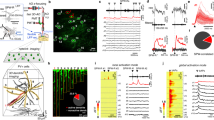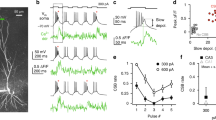Abstract
Basal dendrites are a major target for synaptic inputs innervating cortical pyramidal neurons1. At present little is known about signal processing in these fine dendrites. Here we show that co-activation of clustered neighbouring basal inputs initiated local dendritic spikes, which resulted in a 5.9 ± 1.5 mV (peak) and 64.4 ± 19.8 ms (half-width) cable-filtered voltage change at the soma that amplified the somatic voltage response by 226 ± 46%. These spikes were accompanied by large calcium transients restricted to the activated dendritic segment. In contrast to conventional sodium or calcium spikes, these spikes were mediated mostly by NMDA (N -methyl-D-aspartate) receptor channels, which contributed at least 80% of the total charge. The ionic mechanism of these NMDA spikes may allow ‘dynamic spike-initiation zones’, set by the spatial distribution of glutamate pre-bound to NMDA receptors, which in turn would depend on recent and ongoing activity in the cortical network. In addition, NMDA spikes may serve as a powerful mechanism for modification of the cortical network by inducing long-term strengthening of co-activated neighbouring inputs.
This is a preview of subscription content, access via your institution
Access options
Subscribe to this journal
Receive 51 print issues and online access
$199.00 per year
only $3.90 per issue
Buy this article
- Purchase on Springer Link
- Instant access to full article PDF
Prices may be subject to local taxes which are calculated during checkout





Similar content being viewed by others
References
Larkman, A. U. Dendritic morphology of pyramidal neurons of the rat: Spine distribution. J. Comp. Neurol. 306, 332– 343 (1991).
Cash, S. & Yuste, R. Input summation by cultured pyramidal neurons is linear and position independent. J. Neurosci. 18, 10–15 (1998).
Cash, S. & Yuste, R. Linear summation of excitatory inputs by CA1 pyramidal neurons. Neuron 22, 383 –94 (1999).
Schiller, J., Schiller, Y., Stuart, G. & Sakmann, B. Calcium action potentials in apical dendrites of neocortical pyramidal neurons in rat brain slices. J. Physiol. 505, 605– 616 (1997).
Bliss, T. V. P. & Collingridge, G. L. A synaptic model of memory: Long term potentiation in the hippocampus. Nature 361, 31–39 ( 1993).
Schiller, J., Schiller, Y. & Clapham, D. E. NMDA receptors amplify calcium influx into dendritic spines during associative pre- and postsynaptic activation. Nature Neurosci. 1, 114–118 ( 1998).
Stuart, G. J., Dodt, H. U. & Sakmann, B. Patch-clamp recordings from the soma and dendrites of neurons in brain slices using infrared video microscopy. Pflug. Arch. Eur. J. Physiol. 423, 511–518 (1993).
Koester, H. J. & Sakmann, B. Calcium dynamics in single spines during coincident pre- and postsynaptic activity depend on relative timing of back-propagating action potentials and subthreshold excitatory postsynaptic potentials. Proc. Natl Acad. Sci. USA 95, 9596–9601 (1998).
Hines, M. L. & Carnevale, N. T. The NEURON simulation environment. Neural Comput. 9, 1179– 1209 (1997).
Major, G., Larkman, A. U., Jonas, P., Sakmann, B. & Jack, J. J. B. Detailed passive cable models of whole-cell recorded CA3 pyramidal neurons in rat hippocampal slices. J. Neurosci. 14, 4613–4638 (1994).
Ascher, P. & Nowak, L. The role of divalent cations in the N-methyl-D-aspartate responses of mouse central neurons in culture. J. Physiol. 399, 247–266 (1988).
Hestrin, S., Nicoll, R. A., Perkel, D. J. & Sah, P. Analysis of excitatory synaptic action in pyramidal cells using whole-cell recording from rat hippocampal slices. J. Physiol. 422, 203–225 (1990).
Brodin, L., Traven, H. G. C., Lansner, A., Wallen, P. & Ekeberg, O. Computer simulations of N-methyl-D-aspartate receptor-induced membrane properties in a neuron model. J. Neurophysiol . 66, 473–484 ( 1991).
Brown, A. M., Schwindt, P. C. & Crill, W. E. Voltage dependence and activation kinetics of pharmacologically defined components of the high-threshold calcium current in rat neocortical neurons. J. Neurophysiol. 70, 1530– 1543 (1993).
Jonas, P., Major, G. & Sakmann, B. Quantal components of unitary EPSCs at the mossy fiber synapse on CA3 pyramidal cells of rat hippocampus. J. Physiol. 472, 615–663 (1993).
Martina, M. & Jonas, P. Functional differences in Na+ channel gating between fast-spiking interneurons and principal neurons of rat hippocampus. J. Physiol. 505, 593 –603 (1997).
Destexhe, A., Neubig, M., Ulrich, D. & Huguenard, J. Dendritic low-threshold calcium currents in thalamic relay cells. J. Neurosci. 18, 3574–3588 (1998).
Acknowledgements
We thank. D. E. Clapham, F. Prendergast, B. Sakmann, W. Denk and D. Tank for assistance and support, A. Larkman for reconstructing the cell used in the simulations, and M. Hausser and G. Stuart for reading early versions of the manuscript. In addition we thank the Mayo Foundation, Leo & Frances Kogan endowment fund (J.S.), Wellcome Trust, Lucent Technologies and Marine Biological Laboratory (G.M.) for financial support.
Author information
Authors and Affiliations
Corresponding author
Rights and permissions
About this article
Cite this article
Schiller, J., Major, G., Koester, H. et al. NMDA spikes in basal dendrites of cortical pyramidal neurons. Nature 404, 285–289 (2000). https://doi.org/10.1038/35005094
Received:
Accepted:
Issue Date:
DOI: https://doi.org/10.1038/35005094
This article is cited by
-
Electric field effects on neuronal input–output relationship by regulating NMDA spikes
Cognitive Neurodynamics (2024)
-
Cortico-cortical feedback engages active dendrites in visual cortex
Nature (2023)
-
Deficits in integrative NMDA receptors caused by Grin1 disruption can be rescued in adulthood
Neuropsychopharmacology (2023)
-
Dendritic excitability controls overdispersion
Nature Computational Science (2023)
-
To fire or not to fire: decisions mediated by localized processing and dendritic spikes
Nature Reviews Neuroscience (2023)
Comments
By submitting a comment you agree to abide by our Terms and Community Guidelines. If you find something abusive or that does not comply with our terms or guidelines please flag it as inappropriate.



